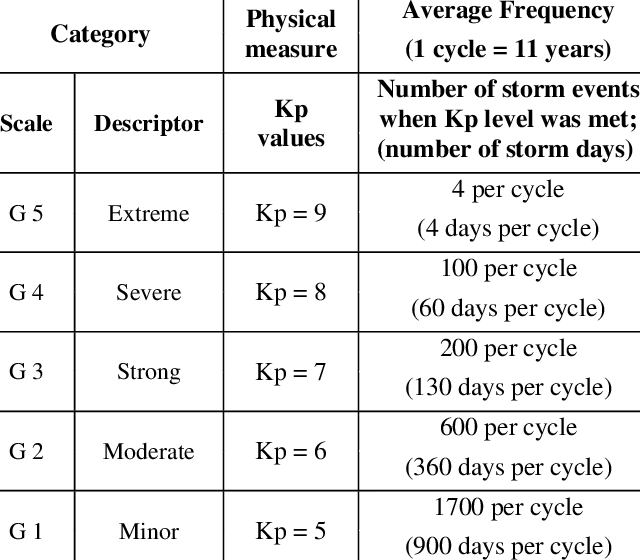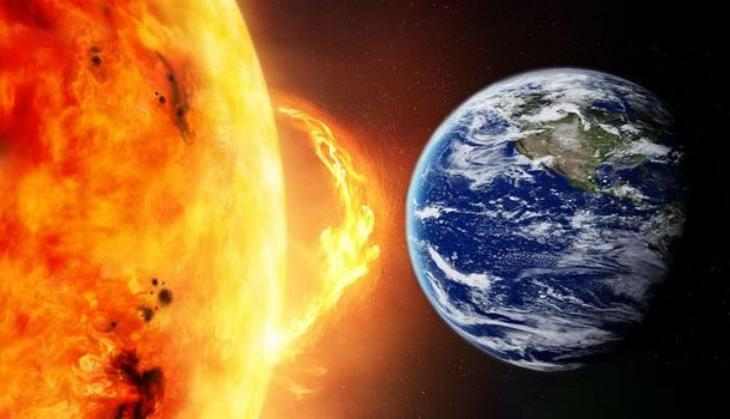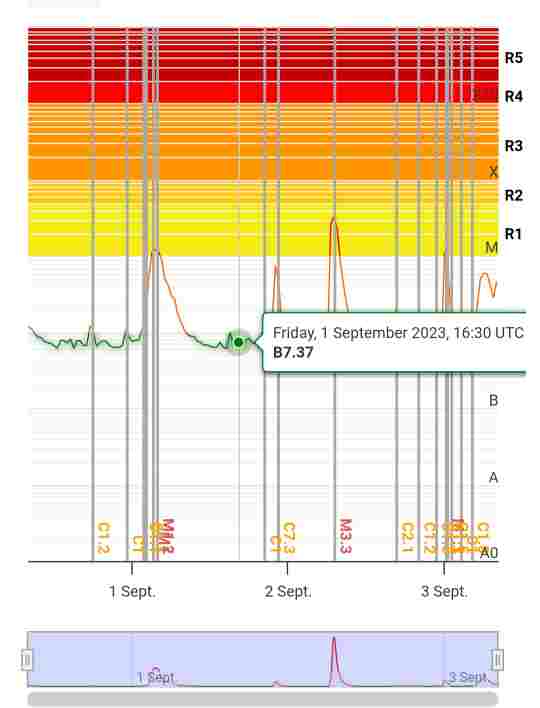Solar Storm Warning Today 2023
A minor geomagnetic storm watch is currently in place for September 3, 2023, UTC-day. On August 30, a solar filament eruption occurred, followed by the detection of an associated partial halo coronal mass ejection (CME) in NASA/SOHO LASCO coronagraph imagery.
In-depth analysis and modeling of the CME suggest a potential Earth-directed component, although there is less certainty regarding its intensity and timing. G1 events are typical throughout a solar cycle, primarily resulting in the possibility of auroras extending further south and becoming visible along the horizons of far northern tier states in the northeast and upper Midwest.
Levels of Solar Storm
Solar storms, also known as geomagnetic storms, are categorized into different levels based on their strength and potential impact on Earth’s magnetic field and technology. The common classification system for solar storms includes:

1. G1 (Minor) –
These are the least severe geomagnetic storms. They can cause minor disturbances in Earth’s magnetic field and are generally not harmful to technology or human health. The main effect is the enhancement of auroras, which may be visible at higher latitudes.
2. G2 (Moderate) –
G2 storms are more intense than G1 storms. They can lead to moderate disruptions in power grids, satellite communications, and navigation systems. Auroras may become visible at lower latitudes during G2 storms.
3. G3 (Strong) –
G3 storms are considered strong geomagnetic storms. They have the potential to cause significant disruptions to power grids and satellite operations. Navigation systems and radio communications can also be affected. Auroras can be observed at even lower latitudes during G3 storms.
You can also read : exploring Microgravity Environment
4. G4 (Severe) –
G4 storms are severe geomagnetic storms with the potential for widespread and prolonged disruptions to power grids, satellite communications, and navigation systems. These storms can also impact pipelines and spacecraft operations. Auroras may be visible at very low latitudes during G4 events.
5. G5 (Extreme) –
G5 storms are the most intense and rarest geomagnetic storms. They can cause widespread and severe disruptions to technology and infrastructure, including power grids, satellite systems, and communication networks. These storms can have significant economic and societal impacts. Auroras may be visible at extremely low latitudes during G5 events.
These classifications help scientists and emergency responders prepare for and mitigate the potential effects of solar storms on Earth. The impact of a solar storm depends on various factors, including its strength, direction, and the state of Earth’s magnetic field at the time of the storm.
How are Solar Storm Formed ?
Solar storms, also known as space weather events, are primarily formed due to the activity on the Sun’s surface. Here’s a simplified explanation of the process:
Solar Flares
Solar storms often start with solar flares, which are sudden, intense bursts of energy and radiation from the Sun’s surface. These are caused by the release of magnetic energy stored in the Sun’s atmosphere.
Coronal Mass Ejections (CMEs)
Solar flares can trigger coronal mass ejections. These are massive eruptions of solar plasma and magnetic fields from the Sun’s corona, the outermost layer of the Sun’s atmosphere. CMEs can contain billions of tons of solar material.
Also read : Popular Color Models in images in Multimedia
Interaction with Earth’s Magnetosphere:
If a CME is directed towards Earth, it can have significant effects on our planet. When the charged particles from the CME reach Earth, they interact with our planet’s magnetic field (magnetosphere).
Impact on Earth
This interaction can lead to various space weather effects, including geomagnetic storms, solar radiation storms, and the disruption of satellite communications and power grids. Auroras, such as the Northern and Southern Lights, can also be intensified during solar storms due to charged particles colliding with gases in Earth’s atmosphere.
These solar storms are closely monitored by space agencies and organizations to predict their impact on Earth and take measures to protect satellites, power grids, and other critical infrastructure.
Major Solar Storms
Here are the major solar storms , along with their categories. Keep in mind that these are just a few examples, and there have been many other solar storm events over the years. Here are a few:
1. Carrington Event (1859) –
This is one of the most famous solar storms in history, although it occurred long before the modern categorization system. It is estimated to have been at least a G5 (Extreme) storm. The Carrington Event caused widespread telegraph system disruptions and auroras seen as far south as the Caribbean.
2. March 1989 Storm –
A G5 (Extreme) storm, this event caused a major power outage in Quebec, Canada, and disrupted power grids in parts of the United States. It also led to satellite communication issues.
3. Halloween Storms (2003) –
A series of severe storms in late October and early November 2003, with some reaching G5 (Extreme) levels. These storms caused minor satellite anomalies and GPS disruptions.
4. March 2012 Storm –
This was a G3 (Strong) storm and resulted in some minor disruptions to power grids and satellite communication systems. It also caused stunning auroras visible at lower latitudes.
5. July 2012 Storm –
Another G3 (Strong) storm, this event had a moderate impact on satellite operations and led to auroras visible in several regions.
6. September 2017 Storm –
This storm reached G4 (Severe) levels and caused significant radio communication issues. It also resulted in vivid auroras seen at lower latitudes.
7. December 2020 Storm –
A G1 (Minor) storm, it caused minimal disturbances and was mostly notable for producing beautiful auroras in high-latitude regions.
Please note that these events vary in their impact depending on factors such as the orientation of the solar storm, the strength of Earth’s magnetic field at the time, and the state of technology. There have likely been many other smaller events not listed here.
Major Solar Storms of 2023 list
January
2023/01/06
2023/01/09
2023/01/10
2023/01/11
2023/01/15
2023/01/25
February
2023/02/07
2023/02/11
2023/02/17
2023/02/20
2023/02/21
2023/02/25
2023/02/28
March
2023/03/03
2023/03/04
2023/03/06
2023/03/29
2023/03/30
May
2023/05/03
2023/05/09
2023/05/16
2023/05/20
2023/05/31
June
2023/06/07
2023/06/20
2023/06/22
July
2023/07/02
2023/07/11
2023/07/12
2023/07/17
2023/07/18
2023/07/26
August
2023/08/05
2023/08/07
2023/08/06


3 thoughts on “Solar Storm warning today 2023”